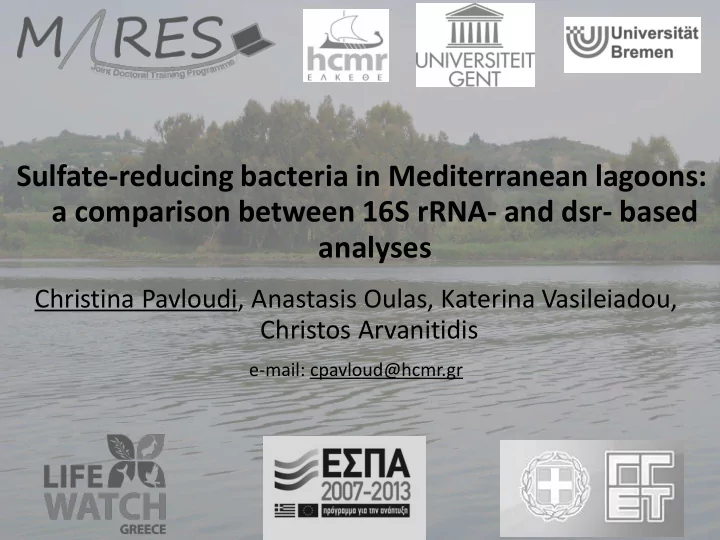

Sulfate-reducing bacteria in Mediterranean lagoons: a comparison between 16S rRNA- and dsr- based analyses Christina Pavloudi, Anastasis Oulas, Katerina Vasileiadou, Christos Arvanitidis e-mail: cpavloud@hcmr.gr
Introduction Lagoons: • naturally enriched habitats • unstable environmental conditions • increased hypoxia • high concentrations of hydrogen sulfide
Introduction
Introduction
Introduction Based on comparative analysis of 16S rRNA sequences, the known SRB can be grouped into seven phylogenetic lineages (Muyzer & Stams, 2008): • Deltaproteobacteria, • Clostridia ( Desulfotomaculum, Desulfosporosinus , Desulfosporomusa ) • Nitrospirae ( Thermodesulfovibrio ) • Thermodesulfobacteria ( Thermodesulfobacterium ) • Thermodesulfobiaceae ( Thermodesulfobium ) • Euryarchaeota ( Archaeoglobus ) • Crenarchaeota ( Thermocladium , Caldirvirga )
Aims • Identification of sulfate reducing communities in hypoxic ecosystems (who?) 16S rRNA: gold standard for estimating phylogenetic diversity in microbial communities multiple-copy little resolution below the species level dsr (dissimilatory sulfite reductase): single-copy protein-coding gene
Methodology - Sampling stations Lagoonal complex of the Amvrakikos Gulf (Ionian Sea, Western Greece)
Methodology - Sampling stations Lagoonal complex of the Amvrakikos Gulf (Ionian Sea, Western Greece)
Methodology
Methodology Collection of sediment samples DNA extraction • PCR amplification • Next generation sequencing Removal of: • PCR errors • Sequencing errors • Chimeras 454 GS FLX Titanium Series
Results - dsr 6,323 OTUs (using the 3% dissimilarity level) 4,172 OTUs correspond to Uncultured Sulfate Reducing Prokaryotes
Results - dsr 6,323 OTUs (using the 3% dissimilarity level) 4,172 OTUs correspond to Uncultured Sulfate Reducing Prokaryotes
Results - dsr 6,323 OTUs (using the 3% dissimilarity level) 4,172 OTUs correspond to Uncultured Sulfate Reducing Prokaryotes
Results - dsr 6,323 OTUs (using the 3% dissimilarity level) 4,172 OTUs correspond to Uncultured Sulfate Reducing Prokaryotes
Results - dsr 6,323 OTUs (using the 3% dissimilarity level) 4,172 OTUs correspond to Uncultured Sulfate Reducing Prokaryotes
Results - dsr 6,323 OTUs (using the 3% dissimilarity level) 4,172 OTUs correspond to Uncultured Sulfate Reducing Prokaryotes
Results - dsr PERMANOVA: Factors: Lagoon (p = 0,001), Location (p = 0,043), Lagoon x Location (p = 0,001)
Results - dsr BIOENV Ammonium Salinity Median Total Reduced Phaeopigments ρ w (uM) (psu) Diameter Inorganic Sulfur (ug/g) (uM/g) + + + 0.585 ** + + + + + 0.466 **
Results - dsr BIOENV Ammonium Salinity Median Total Reduced Phaeopigments ρ w (uM) (psu) Diameter Inorganic Sulfur (ug/g) (uM/g) + + + 0.585 ** + + + + + 0.466 ** Acid Volatile Sulfides: H2S FeS Chromium Reducible Sulfur: S o FeS2
Results - 16S rRNA 14,789 OTUs (using the 3% dissimilarity level) PERMANOVA: Factors: Lagoon (p = 0,001), Location (p = 0,001), Lagoon x Location (p = 0,001)
Conclusions • Each lagoon hosts a different bacterial community. • The occurrence of high numbers of SRB does not necessarily reflect the occurrence of sulfate reduction • 16S rRNA sequencing cannot reveal in depth information on specific functional groups • Metagenomic studies should be employed
Recommend
More recommend